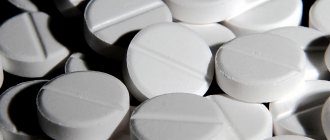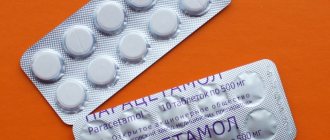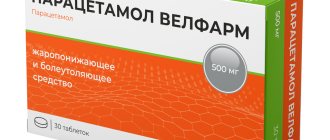PARACETAMOL EXTRATAB
If you are taking other medications with the drug at the same time, you should consult your doctor.
Paracetamol reduces the effectiveness of uricosuric drugs.
With long-term and regular use, paracetamol potentiates the effect of warfarin and other coumarin derivatives and increases the risk of bleeding.
Concomitant use of cholestyramine leads to a decrease in the absorption of paracetamol (and a weakening of the effects of paracetamol).
Metoclopramide and domperidone increase the absorption of paracetamol.
The simultaneous use of paracetamol and non-steroidal anti-inflammatory drugs (metamizole sodium, acetylsalicylic acid, ibuprofen, etc.) increases the risk of developing “analgesic” nephropathy and renal papillary necrosis, end-stage renal failure.
The simultaneous use of paracetamol and chloramphenicol may be accompanied by an increase in the half-life of chloramphenicol by up to 5 times.
Inducers of microsomal liver enzymes (phenytoin, ethanol, barbiturates, rifampicin, phenylbutazone, tricyclic antidepressants) increase the production of hydroxylated active metabolites, which makes it possible to develop severe intoxications even with small overdoses.
Salicylamide increases the half-life of paracetamol, which leads to the accumulation of paracetamol and, accordingly, increased formation of its toxic metabolites.
The simultaneous use of paracetamol and alcohol can increase the hepatotoxicity of paracetamol and also contribute to the development of acute pancreatitis.
Diflunisal increases the plasma concentration of paracetamol by 50%, resulting in an increased risk of hepatotoxicity.
Other medicinal products containing paracetamol should not be used simultaneously with other non-narcotic analgesics.
Ascorbic acid increases the concentration of benzylpenicillin and tetracyclines in the blood; at a dose of 1 g/day increases the bioavailability of ethinyl estradiol (including that included in oral contraceptives); improves the absorption of iron preparations in the intestine (converts ferric iron to divalent iron); may increase iron excretion when used concomitantly with deferoxamine; reduces the effectiveness of heparin and indirect anticoagulants.
Acetylsalicylic acid, oral contraceptives, fresh juices and alkaline drinks reduce the absorption and absorption of ascorbic acid.
When used simultaneously with acetylsalicylic acid, the urinary excretion of ascorbic acid increases and the excretion of acetylsalicylic acid decreases.
Ascorbic acid increases the risk of developing crystalluria during treatment with salicylates and short-acting sulfonamides, slows down the excretion of acids by the kidneys, increases the excretion of drugs that have an alkaline reaction (including alkaloids), and reduces the concentration of oral contraceptives in the blood.
Quinoline drugs, calcium chloride, salicylates, and corticosteroids deplete ascorbic acid reserves when used for a long time.
When used simultaneously, ascorbic acid reduces the chronotropic effect of isoprenaline.
With long-term use or use in high doses, ascorbic acid may interfere with the interaction of disulfiram and alcohol; in high doses increases the excretion of mexiletine by the kidneys.
Barbiturates and primidone increase the excretion of ascorbic acid in the urine.
Ascorbic acid reduces the therapeutic effect of antipsychotic drugs (neuroleptics) - phenothiazine derivatives, tubular reabsorption of amphetamine and tricyclic antidepressants.
Paracetamol Extratab, 10 pcs., 500 mg+150 mg, tablets
If you are taking other medications simultaneously with Paracetamol EXTRATAB, you should consult your doctor.
Paracetamol reduces the effectiveness of uricosuric drugs.
With long-term and regular use, paracetamol potentiates the effect of warfarin and other coumarin derivatives and increases the risk of bleeding. Concomitant use of cholestyramine leads to a decrease in the absorption of paracetamol (and a weakening of the effects of paracetamol).
Metoclopramide and domperidone increase the absorption of paracetamol. The simultaneous use of paracetamol and non-steroidal anti-inflammatory drugs (metamizole sodium, acetylsalicylic acid, ibuprofen, etc.) increases the risk of developing “analgesic” nephropathy and renal papillary necrosis, end-stage renal failure. The simultaneous use of paracetamol and chloramphenicol may be accompanied by an increase in T1/2 of chloramphenicol up to 5 times.
Inducers of microsomal liver enzymes (phenytoin, ethanol, barbiturates, rifampicin, phenylbutazone, tricyclic antidepressants) increase the production of hydroxylated active metabolites, which makes it possible to develop severe intoxications even with small overdoses.
Salicylamide increases T1/2 of paracetamol, which leads to the accumulation of paracetamol and, accordingly, increased formation of its toxic metabolites.
The simultaneous use of paracetamol and ethanol may increase the hepatotoxicity of paracetamol and also contribute to the development of acute pancreatitis. Diflunisal increases the plasma concentration of paracetamol by 50% - the risk of developing hepatotoxicity.
You should not simultaneously use other medicines containing paracetamol, as well as other non-narcotic analgesics. The simultaneous use of other drugs should be agreed with a doctor.
Ascorbic acid increases the concentration of benzylpenicillin and tetracyclines in the blood; at a dose of 1 g/day increases the bioavailability of ethinyl estradiol (including that included in oral contraceptives); improves the absorption of Fe preparations in the intestines (converts ferric iron to divalent iron); may increase iron excretion when used concomitantly with deferoxamine; reduces the effectiveness of heparin and indirect anticoagulants.
Acetylsalicylic acid, oral contraceptives, fresh juices and alkaline drinks reduce the absorption and absorption of ascorbic acid.
When used simultaneously with acetylsalicylic acid, the urinary excretion of ascorbic acid increases and the excretion of acetylsalicylic acid decreases.
Acetylsalicylic acid reduces the absorption of ascorbic acid by approximately 30%.
Ascorbic acid increases the risk of developing crystalluria during treatment with salicylates and short-acting sulfonamides, slows down the excretion of acids by the kidneys, increases the excretion of drugs that have an alkaline reaction (including alkaloids), and reduces the concentration of oral contraceptives in the blood.
Medicines of the quinoline series, CaCl2, salicylates, corticosteroids, when used for a long time, deplete ascorbic acid reserves.
When used simultaneously, ascorbic acid reduces the chronotropic effect of isoprenaline.
With long-term use or use in high doses, ascorbic acid may interfere with the interaction of disulfiram and ethanol; in high doses increases the excretion of mexiletine by the kidneys.
Barbiturates and primidone increase the excretion of ascorbic acid in the urine. Ascorbic acid reduces the therapeutic effect of antipsychotic drugs (neuroleptics) - phenothiazine derivatives, tubular reabsorption of amphetamine and tricyclic antidepressants.
Publications in the media
Paracetamol is included in more than 200 drugs with various brand names, incl. numerous children's liquid forms used as analgesics and antipyretics. Paracetamol is also used in photography and as a textile azo dye. Poisoning usually occurs after a single dose of large doses of combination drugs containing paracetamol, as well as as a result of long-term use of paracetamol in smaller doses due to hypersensitivity to the drug, alcohol abuse, poor diet, or when combined with drugs that affect its metabolism in the liver.
Frequency. Due to the widespread use of paracetamol, the number of poisonings with it has recently increased (including in Russia, especially in children). In 1993, 94,000 cases of poisoning from drugs containing paracetamol were reported to poison control centers in the United States. Of these, in 92 cases the patients died. Etiopathogenesis • In the liver, conjugation of paracetamol with glucuronic acid and sulfate occurs, as well as oxidation by the microsomal system to hepatotoxic intermediate metabolites, including acetimidoquinone (N-acetyl-p-benzoquinone imine; N-acetylimidoquinone), followed by conjugation with glutathione, release of cysteine and mercapturate conjugates • When glutathione reserves are depleted, fulminant (centrilobular) liver necrosis develops. Glutathione depletion in adults usually occurs with paracetamol doses greater than 10 g. Genetic aspects . Non-hemolytic familial jaundice (#143500, ) - the formation of paracetamol glucuronides is seriously impaired, which is potentially dangerous due to the increased formation of hepatotoxic acetimidoquinone. Risk factors • Simultaneous poisoning with other substances, alcoholism, domestic drunkenness • Insufficiency of liver function.
Clinical picture . During poisoning, 4 stages are distinguished depending on the time elapsed after taking the drug and its amount. With long-term use of the drug in subtoxic doses, poisoning can begin with symptoms of any of stages I–III. Symptoms of liver damage are not always obvious, but can develop rapidly from the 2nd to the 5th day after poisoning. • Stage I usually begins a few hours after taking the drug and lasts up to 24 hours •• With mild poisoning, there are no symptoms •• In other cases - symptoms from the gastrointestinal tract (anorexia, nausea and vomiting), pallor of the skin, sweating •• With severe poisoning may cause symptoms of damage to the pancreas and heart •• If consciousness is impaired (stupor, coma), poisoning with another drug (possibly taken together with paracetamol) should be suspected. • Stage II begins after 24 hours after poisoning and lasts up to 3-4 days •• Symptoms from the gastrointestinal tract, possible pain in the right upper quadrant of the abdomen due to liver enlargement •• With a moderate amount of the drug taken, the symptoms do not progress, the patient usually recovers • • With liver damage, the content of AST and ALT, bilirubin in the blood serum increases, and PT is prolonged. • Stage III develops 3-5 days after taking the drug •• Symptoms of toxic liver damage, a further increase in the values of AST, ALT, bilirubin, PT •• In severe cases - signs of impaired consciousness (usually stupor), jaundice, impaired hemocoagulation, hypoglycemia and encephalopathy. Renal failure and myocardiopathy are possible. • Phase IV (after 5 days) - gradual weakening of symptoms of liver damage or death from irreversible liver failure.
Laboratory tests • 4 hours or more after poisoning, the content of paracetamol in the blood plasma is determined (a study carried out earlier than 4 hours is not informative) • When taking long-acting paracetamol preparations, the paracetamol content is recommended to be determined again 4-6 hours after the first analysis. If, during the second determination, the indicator has increased relative to the initial one or is within the range of possible risk (above 75 μg/ml [497 μmol/l]), repeated determinations are necessary every 2 hours until the indicator stabilizes or decreases • Examination of blood plasma for the presence of other toxic substances (for example , acetylsalicylic acid) • The concentration of AST, ALT (sometimes more than 1000 U/l, rarely more than 20,000 U/l) and bilirubin begins to increase at stage II and reaches a maximum at stage III. In case of severe poisoning, a parallel change in PV occurs • In case of liver damage, renal dysfunction is often detected with corresponding changes in blood and urine tests.
Differential diagnosis • It is necessary to identify/exclude the simultaneous intake of other toxic substances, especially alcohol • Paracetamol poisoning is differentiated from food poisoning with toxic substances that cause acute liver damage (for example, Amanita phalloides mushrooms; products containing phosphorus or carbon tetrachlorides).
TREATMENT Diet. A special diet is prescribed only for liver damage - diet options No. 5; with the development of hepatic encephalopathy - a quick change in diet: • Elimination of animal proteins • Sharp limitation or complete exclusion of fats • Introduction of easily digestible carbohydrates - fruit and berry juices rich in K salts (orange, grape, etc.), infusion of dried apricots, apricots, prunes; jelly, compotes • Parenteral nutrition (glucose, isotonic sodium chloride solution, Ringer's solution, thiamine, riboflavin, pyridoxine, cyanocobalamin, ascorbic acid and other vitamins). Management tactics • Immediate gastric emptying: inducing vomiting (emetics), gastric lavage through a tube (effective up to 4 hours after poisoning), enterosorbents (activated carbon) • Specific (antidote) therapy • Symptomatic therapy: treatment of liver failure, etc. Specific (antidote) therapy . To stimulate the formation of glutathione in the liver and prevent the development of liver necrosis - acetylcysteine. It is effective if this therapy is started no later than 10–12 hours after taking the drug; after 16–20 hours the effect is doubtful • Prescribed orally (140 mg/kg and then 70 mg/kg every 4 hours for 3 days) or intravenously (300 mg/kg over 20 hours, half the dose during the first 15 min) • Indicated when the concentration of paracetamol in the blood plasma is not lower than the level of possible risk (150 µg/ml [933 µmol/l], 75 µg/ml [497 µmol/l] and 40 µg/ml [265 µmol/l] through 4, 8 and 12 hours after poisoning, respectively). Nonspecific drug therapy • If the patient is conscious, an emetic, such as ipecac syrup, can be prescribed, especially for children (from 6 months to 1 year - 5 ml, from 1 year to 12 years - 15 ml, after 12 years - 30 ml; give with 240 ml of water), adults - no more than 100-150 mg/kg. If there is no effect, the drug can be repeated after 30 minutes • Activated carbon (1 hour or more after the administration of acetylcysteine) at an initial dose of 1 g/kg.
The prognosis depends on the dose of the drug (toxic dose 140 mg/kg in children, more than 10 g in adults; lethal dose - over 25 g; toxic and lethal dose is much less in alcohol abusers and with chronic liver pathology), timeliness and adequacy assistance provided • Usually - complete recovery if treatment is started in a timely manner and carried out in full (irreversible liver damage develops in less than 1% of adults) • In children under 6 years of age, liver failure is observed very rarely. Age characteristics. Poisoning is possible at any age, half of patients are under 6 years of age • Children under 6 years of age (compared to adults) are more resistant to the toxic effects of paracetamol (liver damage is rare in them) • In adolescents, liver damage is more severe than in adults • In adults liver damage occurs more often with chronic use of hepatotoxic drugs (especially alcohol) • During pregnancy, there is a high risk of spontaneous abortion, especially if poisoned in the early stages.
ICD-10 • T39.1 Poisoning with 4-aminophenol derivatives




